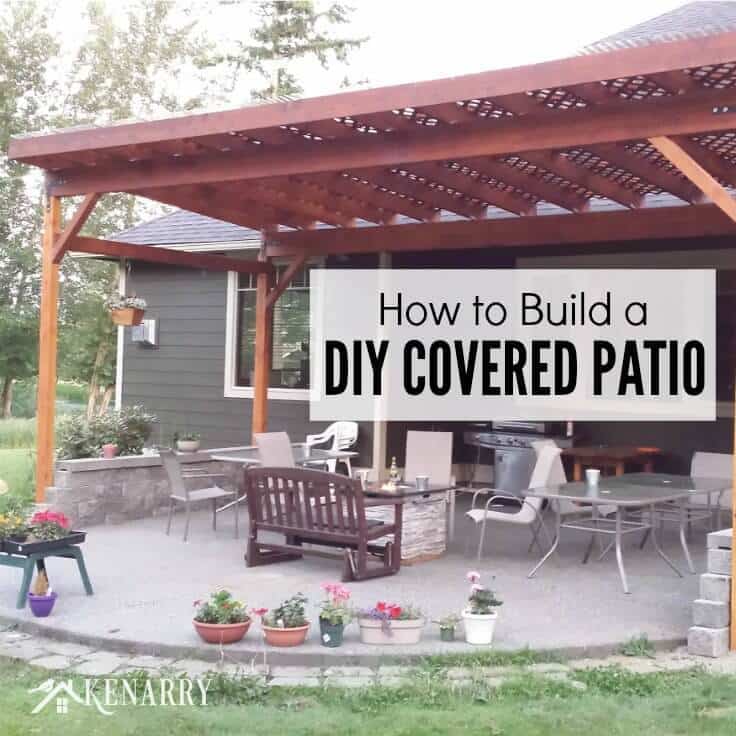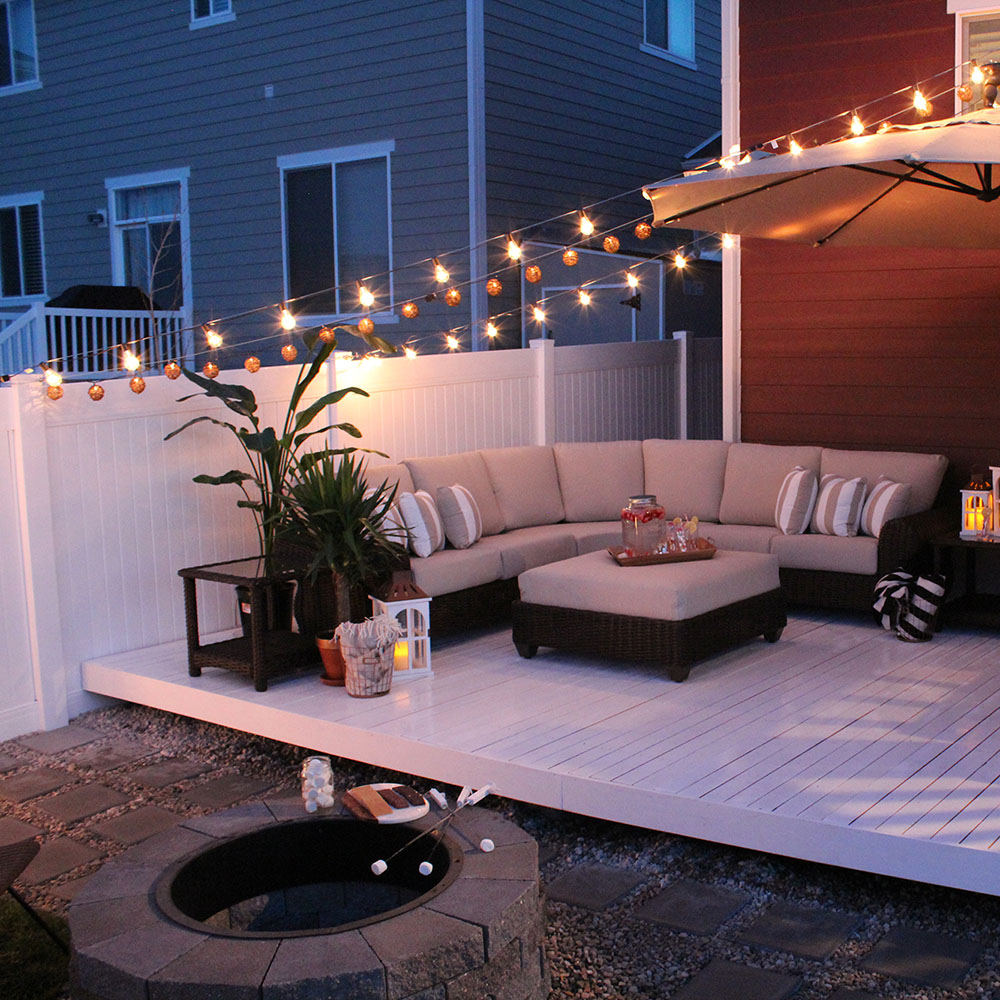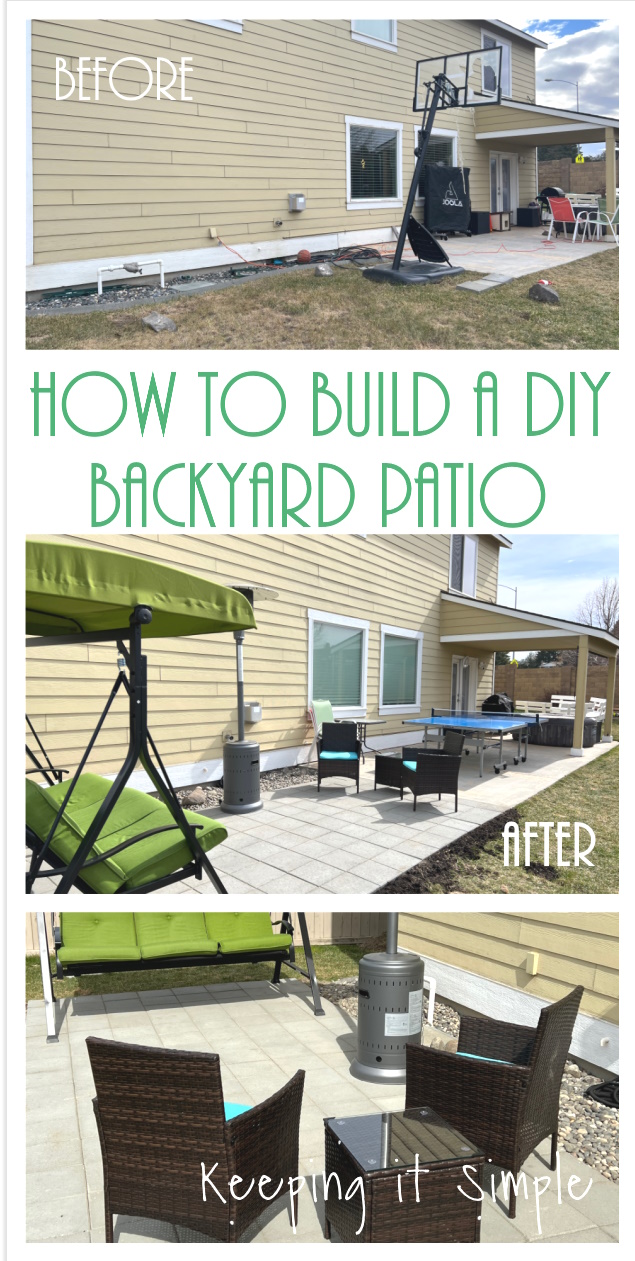To build a backyard patio, start by planning the layout and gathering materials. Next, prepare the ground and install the patio base.
A backyard patio enhances outdoor living spaces, providing a perfect spot for relaxation and entertainment. It can serve as an extension of your home, offering a cozy area for dining, socializing, or simply enjoying the outdoors. Proper planning is crucial for a successful patio project.
Selecting durable materials ensures longevity and beauty. Excavating and leveling the ground is essential for a stable foundation. Installing a solid base layer like gravel or sand helps with drainage and prevents shifting. Finally, laying the chosen patio material, whether pavers, stones, or concrete, completes the project. With careful planning and execution, you can create a beautiful and functional backyard patio.
Introduction To Backyard Patio Projects
Building a backyard patio is a rewarding project. It transforms an outdoor space into a functional area for entertainment and relaxation. A well-designed patio can enhance your home’s value and provide a comfortable place for family gatherings.
Benefits Of Adding A Patio
Adding a patio offers numerous benefits. Here are some key advantages:
- Increases Home Value: A beautiful patio boosts your home’s market value.
- Creates Outdoor Living Space: Enjoy outdoor meals and activities.
- Enhances Aesthetic Appeal: A well-designed patio improves your yard’s look.
- Low Maintenance: Patios require minimal upkeep compared to lawns.
Key Considerations Before Starting
Before beginning your patio project, consider these essential factors:
| Consideration | Details |
|---|---|
| Budget | Determine how much you can spend on materials and labor. |
| Location | Choose a spot with good drainage and adequate sunlight. |
| Material | Select durable materials like concrete, brick, or stone. |
| Size | Decide on a size that fits your yard and needs. |
| Design | Plan a layout that complements your home and garden. |
Planning and preparation are crucial for a successful patio project. By considering these factors, you ensure a smooth process and a stunning result.

Credit: www.kenarry.com
Designing Your Patio
Designing a patio is an exciting step in creating your backyard oasis. This involves choosing the right spot, materials, and shapes for your patio. Thoughtful planning can help you build a beautiful and functional outdoor space.
Choosing The Right Location
The location of your patio is crucial. Look for a spot with good drainage. Avoid low areas where water collects. Consider the view from your patio. A spot near your house is convenient. Think about privacy and noise too. Try to choose a spot with some shade.
Selecting Materials And Styles
Patio materials come in many types. Popular choices include concrete, brick, and pavers. Each material has its pros and cons:
| Material | Pros | Cons |
|---|---|---|
| Concrete | Durable, easy to maintain | Can crack over time |
| Brick | Classic look, long-lasting | More expensive, labor-intensive |
| Pavers | Versatile, easy to replace | Can shift or settle |
Choose a style that matches your home. You can go modern, rustic, or classic. Think about colors and patterns too.
Planning For Size And Shape
Decide on the size of your patio. A small patio is cozy and intimate. A large patio is great for parties and gatherings. Measure the area to make sure it fits your needs.
Choose a shape that complements your backyard. Common shapes include square, rectangular, and circular. You can also get creative with custom shapes.
- Square: Simple and easy to plan
- Rectangular: Ideal for dining areas
- Circular: Adds a unique touch
Consider the furniture and features you want. Leave enough room for movement and activities.
Budgeting And Planning
Building a backyard patio is an exciting project. To ensure success, start with proper budgeting and planning. This will save you time and money. Detailed planning helps avoid unexpected costs and delays.
Estimating Costs
Estimating costs is the first step in your patio project. Create a list of materials and tools needed. This includes:
- Patio pavers or stones
- Sand and gravel
- Edging materials
- Tools like shovels, rakes, and a level
- Labor costs if hiring professionals
Research prices for each item. Compare options to find the best deals. Here is a simple table to help you track expenses:
| Item | Estimated Cost |
|---|---|
| Patio Pavers | $500 |
| Sand and Gravel | $200 |
| Edging Materials | $150 |
| Tools | $100 |
| Labor Costs | $600 |
Add a buffer to your budget for unexpected expenses. A 10-15% buffer is recommended.
Timeline And Project Stages
Divide your project into clear stages. This helps manage time and resources. Here’s a simple timeline:
- Planning and Design: 1 week
- Gathering Materials: 1 week
- Site Preparation: 2-3 days
- Laying the Base: 1 week
- Installing Pavers: 1 week
- Finishing Touches: 2-3 days
Each stage has specific tasks. In the planning stage, finalize your design and obtain necessary permits. During the gathering materials stage, source all required items. The site preparation stage involves clearing the area and marking boundaries.
For the laying the base stage, spread and level sand and gravel. In the installing pavers stage, place the pavers according to your design. Finally, in the finishing touches stage, add edging and fill gaps with sand.
Gathering Tools And Materials
Building a backyard patio starts with gathering the right tools and materials. This step is crucial for a smooth and successful project. Below are the essential tools and where to source the best materials.
Essential Tools For The Job
You will need a few essential tools for this project. These tools will help you with digging, leveling, and laying the patio.
- Shovel: For digging out the patio area.
- Level: Ensures the patio surface is flat.
- Tape Measure: Measures the dimensions accurately.
- Rubber Mallet: Helps set the pavers without breaking them.
- Wheelbarrow: For moving materials easily.
- Garden Rake: Smooths out the soil.
Sourcing Materials
Gathering the right materials is key. You need materials that are durable and weather-resistant.
| Material | Description | Where to Buy |
|---|---|---|
| Pavers: | Sturdy stones for the patio surface. | Home improvement stores or online. |
| Gravel: | Base layer for drainage. | Landscape supply centers. |
| Sand: | To level the pavers. | Local hardware stores. |
| Edging: | Keeps the pavers in place. | Garden centers or online. |
Preparing The Site
Before you start laying pavers or pouring concrete, you need to prepare the site. This step ensures your patio will be durable and level. It involves two main tasks: clearing and leveling the ground, and marking the layout. Let’s dive into these steps to get your backyard patio project off to a great start.
Clearing And Leveling The Ground
First, remove any grass, weeds, or debris from the area. Use a shovel to dig out the top layer of soil. Aim for a depth of 6-8 inches. This depth allows room for the base materials and pavers.
Next, level the ground. Use a rake to smooth the surface. Check for any high or low spots. Use a leveling tool to ensure the ground is even. Compact the soil with a tamper to create a solid foundation.
Marking The Layout
Now, outline your patio’s shape. Use stakes and string to mark the edges. Ensure the layout matches your design plan. Measure the dimensions carefully to avoid mistakes.
For curved edges, use a garden hose or flexible rope. This helps you visualize the final shape. Adjust the layout as needed until satisfied. Double-check measurements before moving on.
Once the layout is marked, you’re ready for the next step in building your backyard patio. The proper site preparation ensures your patio will be strong and level.

Credit: www.homedepot.com
Laying The Foundation
Building a backyard patio starts with a solid foundation. This ensures the patio is durable and lasts for years. Proper foundation work prevents future issues like sinking or cracking. Below, we explore two key steps for laying the foundation: Digging and Pouring Footings and Installing Pavers or Concrete.
Digging And Pouring Footings
Footings are the base of your patio. They provide essential support. Begin by marking the patio’s area with stakes and string. This helps you see the patio’s shape.
Next, dig holes for the footings. The depth depends on your soil type and climate. A common depth is 12 inches. Ensure the holes are even and level. Use a spirit level for accuracy.
Mix concrete according to the package instructions. Pour the concrete into the holes. Fill each hole to ground level. Use a trowel to smooth the surface. Allow the concrete to cure for at least 24 hours.
Installing Pavers Or Concrete
After the footings are ready, choose between pavers or concrete for your patio surface. Each option has its benefits.
Installing Pavers:
- Lay a base layer of gravel. Compact it using a plate compactor.
- Spread a layer of sand on top of the gravel. Smooth it out.
- Place the pavers on the sand. Ensure they are tight and even.
- Fill the gaps with sand. Sweep it into the cracks.
- Compact the pavers again to set them in place.
Pouring Concrete:
- Mix the concrete according to package instructions.
- Pour the concrete over the prepared area.
- Use a screed board to level the concrete surface.
- Allow the concrete to cure for at least 48 hours.
- Finish the surface with a trowel for a smooth look.
Both methods create a strong, durable patio foundation. Choose the one that fits your style and needs.
Adding Aesthetics And Functionality
Creating a backyard patio involves more than just laying stones or bricks. Adding aesthetics and functionality can transform your outdoor space into a stunning retreat. These enhancements make your patio more enjoyable and visually appealing. Let’s explore how you can add these elements effectively.
Incorporating Outdoor Lighting
Outdoor lighting can set the mood for your patio. Choose warm lights for a cozy feel. Use LED string lights to create a magical ambiance. Solar-powered lights are eco-friendly and cost-effective. Install path lights for safety and beauty. Place uplights near plants to highlight their features.
- String lights for ambiance
- Solar lights for eco-friendliness
- Path lights for safety
- Uplights for highlighting plants
Furniture And Accessories
Choosing the right furniture can add both style and comfort. Select weather-resistant furniture to withstand the elements. A mix of chairs, sofas, and tables works well. Add colorful cushions for a pop of color. Use a rug to define the seating area. Consider a fire pit for warmth and a gathering spot.
| Item | Purpose |
|---|---|
| Weather-resistant chairs | Durability and comfort |
| Colorful cushions | Adds color and comfort |
| Outdoor rug | Defines space |
| Fire pit | Warmth and ambiance |
Accessories can elevate your patio’s look. Add plants for a touch of nature. Use lanterns and candles for a soft glow. A water feature can add a soothing sound. Consider a pergola for shade and structure.
- Plants for natural beauty
- Lanterns and candles for soft lighting
- Water feature for soothing sounds
- Pergola for shade
Maintenance And Upkeep
Building a backyard patio is just the beginning. Keeping it in top shape requires regular maintenance and upkeep. Follow these tips to ensure your patio remains a beautiful and functional outdoor space.
Regular Cleaning Tips
Regular cleaning is essential for a pristine patio. Here are some tips:
- Sweep the patio weekly to remove debris.
- Hose down the surface to get rid of dirt.
- Use a mild detergent for stubborn stains.
- Scrub with a soft-bristle brush to avoid damage.
- Rinse thoroughly to ensure no soap residue remains.
For deeper cleaning:
- Move all furniture and plants.
- Use a pressure washer on a low setting.
- Focus on areas with mold or mildew.
- Allow the patio to dry completely before replacing items.
Seasonal Maintenance Routines
Adopt seasonal maintenance routines to keep your patio looking great all year.
| Season | Task |
|---|---|
| Spring | Inspect for cracks and reseal if needed. |
| Summer | Check for weeds and remove them promptly. |
| Fall | Clear away fallen leaves and debris. |
| Winter | Cover furniture and protect against snow and ice. |
By following these tips, your backyard patio will remain a beautiful space for years to come.
Common Pitfalls To Avoid
Building a backyard patio can be very rewarding. Yet, it’s easy to run into problems. Here are common pitfalls to avoid. These will help you create a durable and beautiful patio.
Permitting Issues
Many people skip getting the proper permits. This can lead to fines or even tearing down your patio. Always check local regulations before starting.
- Visit your local government office.
- Ask about needed permits for construction.
- Fill out all required forms.
Make sure you have everything in order. This will save you time and stress later.
Drainage And Weather Considerations
Ignoring drainage can ruin your patio. Water pooling can cause cracks and other damage. Plan for proper drainage to keep your patio in top shape.
| Issue | Solution |
|---|---|
| Water pooling | Install a slope for runoff. |
| Heavy rain | Use permeable materials. |
Weather is another factor to consider. In areas with freezing temperatures, use materials that can withstand the cold. This will help your patio last longer.
By addressing these common pitfalls, you’ll ensure your backyard patio is a success. Happy building!

Credit: ashleybrooke.com
Expanding Your Patio Space
Expanding your patio space can transform your backyard. You can create a larger area for entertaining, relaxing, and enjoying the outdoors. There are many ways to expand your patio. Let’s explore some ideas.
Integrating With Landscaping
Integrating your patio with landscaping creates a seamless look. Consider adding flower beds around the patio edges. Use plants that complement your patio’s design.
Here’s a simple table of plants that work well:
| Plant | Light Requirement | Water Needs |
|---|---|---|
| Lavender | Full Sun | Low |
| Hosta | Partial Shade | Medium |
| Rosemary | Full Sun | Low |
Using different heights in your landscaping adds depth. Small trees and shrubs can provide privacy. Paths and walkways can connect different areas.
Future Additions And Upgrades
Plan for future additions and upgrades to keep your patio versatile. Consider these ideas:
- Outdoor Kitchen: A built-in grill and counter space.
- Fire Pit: A cozy spot for evening gatherings.
- Water Features: A fountain or small pond for tranquility.
Think about adding more seating options. Built-in benches or moveable furniture can provide flexibility. Shade structures, like pergolas or umbrellas, can make your patio comfortable on sunny days.
Keep expanding your patio space in mind as you plan. This will allow for easy adjustments and improvements.
Frequently Asked Questions
What Is The Cheapest Way To Make An Outdoor Patio?
Use gravel or crushed stone for the cheapest patio. Lay a weed barrier, spread gravel, and compact it. Add simple, inexpensive furniture for a functional outdoor space.
Can You Build A Patio By Yourself?
Yes, you can build a patio by yourself. You’ll need proper tools, materials, and a detailed plan. Ensure you follow safety guidelines.
What Is The Easiest Type Of Patio To Put In?
The easiest type of patio to install is a gravel patio. It’s affordable, requires minimal tools, and offers flexible design options. Gravel patios are low maintenance and great for drainage.
How To Lay A Patio For Beginners?
Start by marking the patio area. Excavate the ground to a depth of 150mm. Add a compacted layer of hardcore. Spread and level sand, then lay the paving slabs. Ensure slabs are evenly spaced and level. Fill gaps with jointing compound.
What Are The Steps To Building A Patio?
Clear the area and mark the patio boundaries. Excavate the site to the required depth. Lay a gravel base and compact it. Install edge restraints. Lay pavers or patio stones, filling gaps with sand.
Conclusion
Building a backyard patio is a rewarding project. It enhances outdoor living space and adds value to your home. By following these steps, you can create a beautiful, functional patio. Enjoy relaxing and entertaining in your new outdoor haven. Happy building and don’t forget to share your patio success stories!

